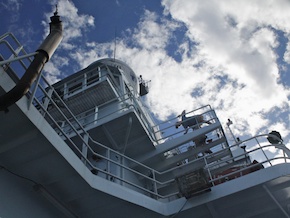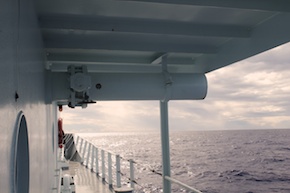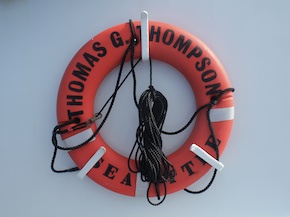The R/V Thomas G. Thompson left Honolulu on November 5, 2011 heading toward the Western Pacific. This expedition journal was written by cruise participants and uploaded about once per weekday, depending on internet availability.
November 18, 2011: The TGT, History and Overview

Upper decks (Credit: Nick Mathews)
Just by looking at her, it’s almost hard to believe that the very ship we call “home” here in the Western Pacific is in the middle of her 40-year anticipated lifetime. The R/V Thomas G. Thompson was built by the United States Navy specifically for the purpose of academic research and has been doing so faithfully since her launch in July 1991. Through the Office of Naval Research, the University of Washington’s School of Oceanography has operated the Thompson under a Charter Party agreement. Over the past 20 years of her life, the Thompson and her crew have conducted a wide variety of missions/research cruises in several oceans, demonstrating their great utility and adaptability.
To get a better glimpse at what the R/V Thompson is all about, I sat down with able seaman (AB) Brian Clampitt to discuss some of the ship’s past. He informed me that the majority of missions the Thompson conducts take place within the relatively native waters of the Pacific and focus on geophysical research. For about the first ten years of the Thompson's life, she spent a lot of her time in and around the East Indian Ocean; however, over the past ten years, she’s been staying a little closer to home. Some of her more recent duties took her to the Northeast Pacific, to the Bering Sea off the coast of Alaska (as well as in and around British Columbia) and south-southwest working around Hawaii, Samoa, and New Zealand. During one of the longest cruises, the ship stretched her legs to reach a destination east of the Strait of Magellan, going around Cape Horn, South America.
One particularly memorable research cruise that Brian recalls, again demonstrating the ship’s utility, was when the Thompson was sent to Samoa with the remotely operated vehicle (ROV) Jason in order to conduct underwater volcanic surveys. With a bit of luck and persistence, the ship, crew, and scientists guided Jason into an area with recent underwater volcanism (about 2500 meters deep) when they observed an active underwater eruption. “We could just see the dome build up and up and up, and then ‘Poof!’ sending debris and bright red chunks of lava all over the ocean floor – it was incredible,” said Brian.

Flume ejection pipe (Credit: Nick Mathews)
Brian also informed me that despite all the technological intricacies of the ship, there are much simpler, fundamental things that make her what she is. For example, the Thompson was designed to be a stiff ship, being stout and rigid in adverse sea states. However, this does come at a small cost; being stiff also means that when the ship is rolling with the waves, it will tend to be jerky and “snap” back upright – potentially causing interesting scenarios throughout the ship. In order to counteract the jerkiness, a container known as the flume tank was installed to slightly destabilize the ship when it's being rolled. The tank is filled with water, allowing the free-moving weight to shift against the roll, slowing the effect of the "snap.” If it is ever necessary to “re-stabilize” the Thompson, whether due to a rising sea state or weather conditions, the flume can be quickly emptied through large pipes with release valves located near the library. This is a necessary feature for the Thompson, especially when she makes her way north to shallower and rougher Alaskan waters.

Just in case (Credit: Nick Mathews)
The magnetic survey we are conducting in the waters of the Western Pacific is yet another change of pace for both the ship and its crew. With fair winds at our backs, this expedition will also be added to the ship’s successful history. ♦
